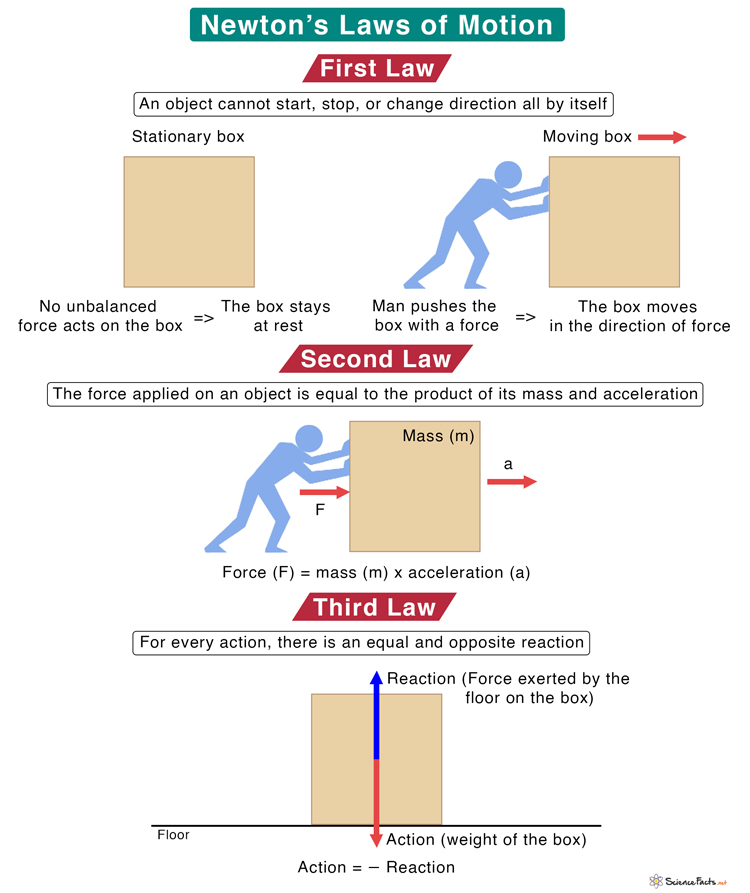Newton’s Laws of Motion
What are Newton’s Laws of Motion
Newton’s laws of motion are a set of three laws that govern the motion of an object. They describe a relationship between the motion and the forces acting on the object. Newton’s laws are important because they set up the foundations of classical physics and revolutionized our understanding of the motion of objects.
The laws have been named after English mathematician and physicist Sir Isaac Newton. He published them in 1687.
What are the Laws of Motion
There are three laws of motion due to Newton. They are known as First, Second, and Third Laws.
1. First Law
Statement: “An object at rest remains at rest, and object in motion remains at a constant speed and in a straight line unless acted upon by an unbalanced force”.
According to the first law, an object cannot start, stop, or change direction all by itself. In order to cause an action, it will require force.
Consider the case where the object is at rest. It is because either no forces act on it or all the external forces cancel each other. It will remain at rest unless an unbalanced force displaces it.
Example: A book lying on a table.
Consider the case where the object is moving at a constant speed in a straight line. It will continue to move with the same speed and remain in a straight line as long as no external force acts on it. If there is an external force, the object will either change its direction, accelerate or decelerate, or come to a stop.
Example 1: A car moving on a road at a constant speed comes to a stop when the brakes are applied. Here, the action of applying brakes is the force responsible for stopping the car.
Example 2: A balloon moving in a straight line will continue to move in the same direction unless the wind sweeps it and changes its direction. Here, the wind is the force responsible for changing the direction of the balloon. The balloon can come to a stop if it is stuck in a tree. In this case, the tree applies force responsible for ceasing the motion of the balloon.
The first law is also known as the law of inertia.
2. Second Law
Statement: “When an object is in motion, its acceleration depends upon its mass and the applied force”.
The second law defines a force on an object given by the product of its mass and acceleration.
Consider two objects of different masses – one heavy and another light. If the same force is applied to both the objects, the lighter one will move faster than the heavier one.
Example 1: A rock rolling down a hill due to gravity. It will roll down with a constant acceleration, whose value will depend upon the mass of the rock and the angle of inclination of the hill.
Example 2: A ball falling through the air with acceleration g due to Earth’s gravity. The Earth pulls the ball with a force given by the product of the ball’s mass and acceleration due to gravity. This force is equal to the ball’s weight. A heavier ball will experience more force.
Equation:
Mathematically, the second law is written as follows.
Force (F) = mass (m) x acceleration (a)
Or, F = ma
3. Third Law
Statement: “If one object exerts a force on another object, then the other object exerts an equal and opposite force on the first object”.
According to the third law, for every action, there is an equal and opposite reaction.
Consider two objects A and B colliding with one another. A strikes B with force, which is the action. B reacts by exerting a force on A, which is the reaction. According to the third law, action and reaction forces are equal and opposite. Therefore, this law is also known as action-reaction law.
Example 1: The thrust of a rocket produces the force required to lift the rocket from Earth. Here, the thrust is the action, and the lift of the rocket is the reaction.
Example 2: When a person stands on Earth’s surface, they experience a force due to gravity. The person’s weight is the action, and the force exerted by Earth on them is the reaction.
-
References
Article was last reviewed on Monday, December 20, 2021








